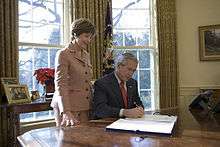Ryan White CARE Act
.svg.png) | |
| Long title | An Act to amend the Public Health Service Act to provide grants to improve the quality and availability of care for individuals and families with HIV disease, and for other purposes. |
|---|---|
| Nicknames |
|
| Enacted by | the 101st United States Congress |
| Effective | August 18, 1990 |
| Citations | |
| Public law | 101-381 |
| Statutes at Large | 104 Stat. 576 |
| Codification | |
| Titles amended | 42 U.S.C.: Public Health and Social Welfare |
| U.S.C. sections created | 42 U.S.C. ch. 6a, subch. XXIV § 300ff et seq. |
| U.S.C. sections amended | 42 U.S.C. ch. 6a, subch. XXIII § 300ee et seq. |
| Legislative history | |
| |
The Ryan White Comprehensive AIDS Resources Emergency Act (Ryan White CARE Act, Pub.L. 101–381, 104 Stat. 576, enacted August 18, 1990), was an act of the United States Congress and is the largest federally funded program in the United States for people living with HIV/AIDS. The act sought funding to improve availability of care for low-income, uninsured and under-insured victims of AIDS and their families.[1] The act is named in honor of Ryan White, an Indiana teenager who contracted AIDS through a tainted hemophilia treatment. He was diagnosed with AIDS in 1984 and was subsequently expelled from school because of the disease. White became a well-known advocate for AIDS research and awareness, until his death on April 8, 1990.[2]
Unlike Medicare or Medicaid, Ryan White programs are "payer of last resort" which fund treatment when no other resources are available. As AIDS has spread, the funding of the program has increased. In 1991, the first year funds were appropriated, around US$220 million were spent; by the early 2000s, this number had almost increased 10-fold. The Act was reauthorized in 1996, 2000, 2006, and 2009. The program provides some level of care for around 500,000 people a year and, in 2004, provided funds to 2,567 organizations. The Ryan White programs also fund local and state primary medical care providers, support services, healthcare provider training programs, and provide technical assistance to such organizations.[1]
In fiscal year 2005, federal funding for the Ryan White CARE Act was $2.1 billion. As of 2005, roughly one-third of this money went to the AIDS Drug Assistance Programs (ADAP) which provides drugs for 30 percent of HIV-infected patients.[3] The primary activity of ADAP is providing FDA-approved prescription medication.[4]
The Ryan White CARE Act mandates that EMS personnel can find out whether they were exposed to life-threatening diseases while providing care. (This notification provision was included in the original 1990 act, dropped in the 2006 reauthorization, and reinstated in the 2008 reauthorization).[5]
2006 reauthorization

The Ryan White Care Act was due to be reauthorized at the end of 2005, but Congress could not reach agreement on changes, and the act was extended for one year under the old terms.[6] In 2006, the act was reauthorized for three more years, ending on September 30, 2009 with a funding level of $2.1 billion.[7]
Prior to the reauthorization, the act allocated money based on the proportion of patients with AIDS in each region. The 2006 reauthorization changed this allocation mechanism to also consider the number of people without an AIDS diagnosis but who still have HIV infection.[7] A significant portion of funding from the act is emergency relief for Eligible Metropolitan Areas. The 2006 reauthorization redefined EMAs as cities with a population greater than 50,000, instead of previous versions which required 500,000.[6]
2009 reauthorization

| Wikisource has original text related to this article: |
In 2009, Congress passed the Ryan White HIV/AIDS Treatment Extension Act,[8] which was signed by President Obama on October 30, 2009.[9] This bill extends the Ryan White Care Act for an additional four years.[10]
References
- 1 2 "The Ryan White HIV/AIDS Program". Health Resources and Services Administration, HHS. Retrieved 2007-09-11.
- ↑ Dirk Johnson (1990-04-09). "Ryan White Dies of AIDS at 18; His Struggle Helped Pierce Myths". The New York Times.
- ↑ AIDS Drug Assistance Programs (ADAPs) - Henry J. Kaiser Family Foundation Fact Sheet
- ↑ Jessamy Taylor (2005-08-22). Caring for "Ryan White": The Fundamentals of HIV/AIDS Treatment Policy (PDF). The George Washington University. Retrieved 2007-09-09.
- ↑ Announcements: Reinstatement of Notification Requirements for Emergency Response Employees Potentially Exposed to Life-Threatening Infectious Diseases; Occupational Exposure to HIV
- 1 2 "The Ryan White CARE Act: A Side-by-Side Comparison of Prior Law to the Newly Reauthorized CARE Act" (PDF). Kaiser Family Foundation. December 2006. Retrieved 2007-09-12.
- 1 2 Deb Reichmann (2006-12-19). "Bush Signs 3 Health Care-Related Bills". The Washington Post. Associated Press. Retrieved 2007-09-12.
- ↑ "S.1793: Ryan White HIV/AIDS Treatment Extension Act of 2009". GovTrack.
- ↑ "Remarks by the President at Signing of the Ryan White HIV/AIDS Treatment Extension Act of 2009".
- ↑ "Statement of Administration Policy: S.1793: Ryan White HIV/AIDS Treatment Extension Act of 2009" (PDF). Office of Management and Budget.